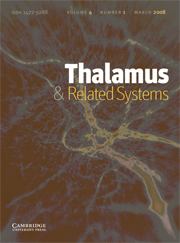Article contents
Kainate receptors at corticothalamic synapses do not contribute to synaptic responses
Published online by Cambridge University Press: 12 April 2006
Abstract
Kainate receptors (KAR) remain the most poorly defined components of the glutamate receptor system in the CNS, mainly because of the difficulty of distinguishing currents gated by KAR from those mediated by α-amino-3-hydroxy-5-methyl-4-isoxazole propionate (AMPA) receptor activation, and because KAR are expressed at significantly lower levels than AMPA receptors in most parts of the CNS.
The corticothalamic projection exerts its effects on thalamic neurons via NMDA, non-NMDA and metabotropic glutamate receptors. AMPA receptor mediated effects tend to predominate in the mature thalamus, but the involvement of kainate receptors at corticothalamic synapses on relay neurons and reticular nucleus neurons had not been studied.
The present work compared KAR influences on neurons in the ventral posterior nucleus (VP) and reticular nucleus (RTN), using whole-cell recording in P14–P20 mouse thalamocortical slices. The results were correlated with quantitative immuno-electron microscopic localization of kainate receptor sub-units at corticothalamic synapses in these nuclei. Small kainate-induced inward currents could be recorded in thalamic neurons in response to bath application of kainate, but no KAR-mediated pre-synaptic effects could be detected and no synaptic responses could be evoked in these cells by corticothalamic stimulation. Morphologically, GluR5/6/7 sub-units were expressed at low levels in both VP and RTN and were confined to post-synaptic membranes at corticothalamic synapses in both VP and RTN. Many synapses, however, lacked GluR5/6/7 immunoreactivity.
These results suggest that kainate receptor-mediated events are not major components of the responses of thalamic neurons to corticothalamic activation, either because of small numbers or their location in sites inaccessible to glutamate released from corticothalamic terminals.
Keywords
- Type
- Research Article
- Information
- Copyright
- 2001 Elsevier Science Ltd
- 3
- Cited by


